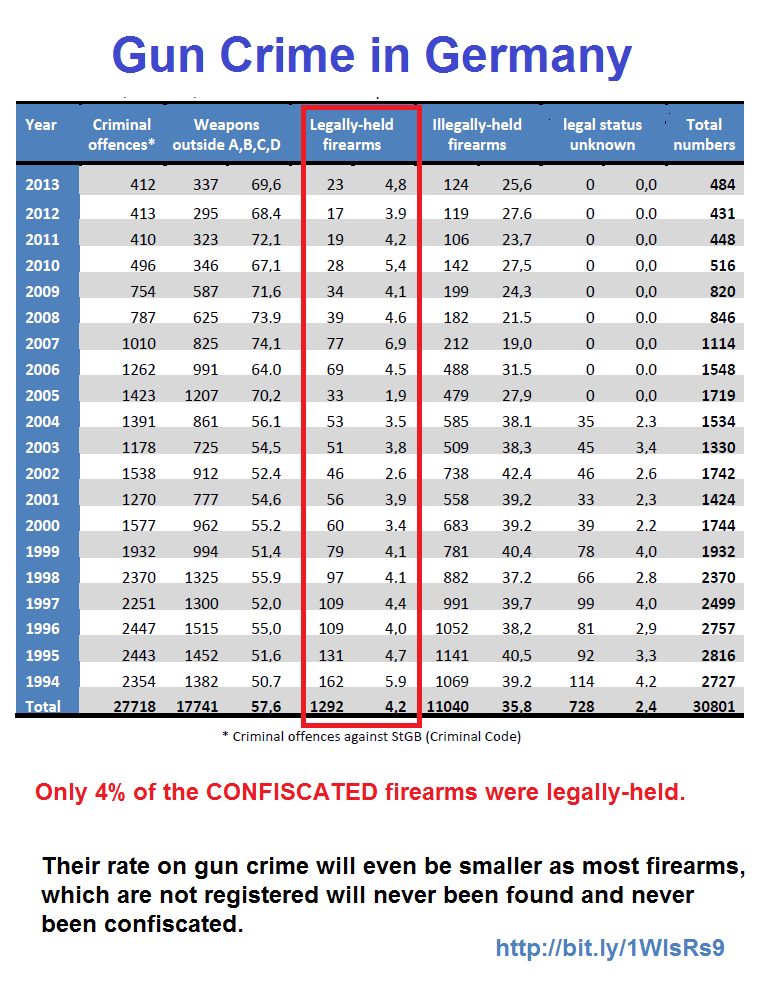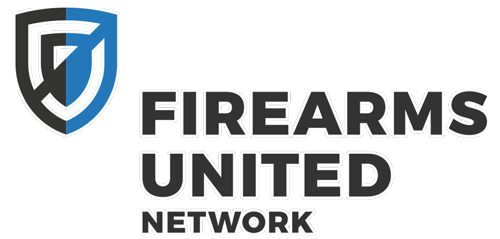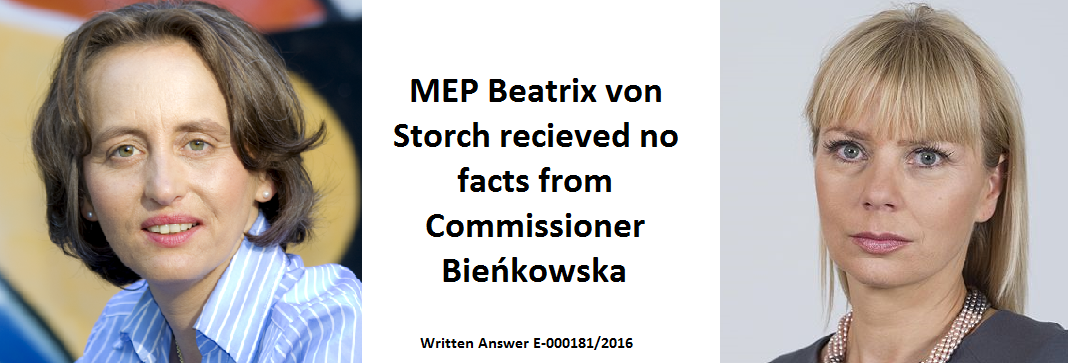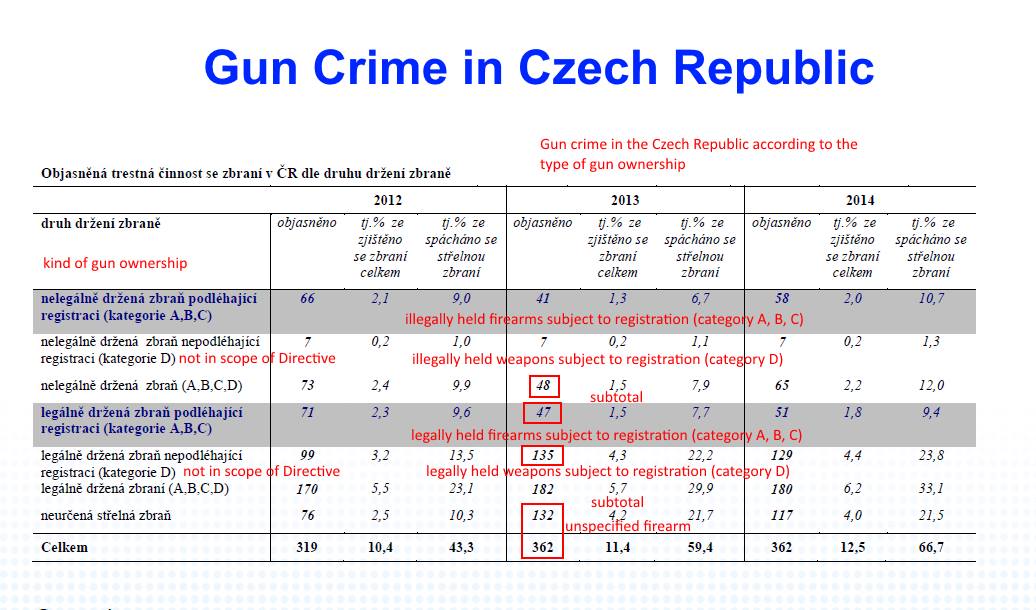When MEP Beatrix von Storch asked the European Commission (COM) to prove the “dangerousness” of legally-held firearms and especially of category B firearms Commissioner Elżbieta Bieńkowska did not answer her question at all. She only gave examples and assumptions and misused massacres as an argument for bans.
Questions by Beatrix von Storch (MEP) from January 2016:
How many of the annual 1 000 (or 10 000 over the last decade) firearms-related homicides have been committed using legally held firearms or stolen firearms that previously belonged to legal owners? Please report figures for the last 10 years, broken down by firearms category A, B, C, D, and by Member State.
How many weapons transformed into automatic firearms that had previously been registered as semi-automatic firearms for law-abiding gun owners have been misused in the last 10 years? Please report figures by Member State and by category B1 to B7.
Answers by Ms Bieńkowska (COM) from May 2016:
On 18 November 2015, the Commission adopted a report on the application of the existing Firearms Directive based on a thorough evaluation study.
The evaluation study pointed to the fact that in a number of Member States there was a misuse of legally held firearms. The study gives examples of relationships between crime and legally held firearms as reported by relevant authorities in the Member States. For example in Finland, on average, approximately 20-30 cases of homicides are committed through the use of firearms every year with less than 10 being with legal firearms. Another example is in the Czech Republic where in 2013, it was reported that legal firearms were four times as likely to be used compared to illegal firearms.
Apart from the conclusions from the evaluation study, a number of massacres which have taken place in Europe in the past years have been carried out with legal firearms. Examples include a shooting incident in Nanterre in France in 2002, the Jokela school shooting in Finland in 2007, the Winnenden school shooting in Germany in 2009, the Cumbria shooting in England in June 2010 and the shootings in Ridderhof mall in the Alphen aan den Rijn in the Netherlands in 2011. In a majority of firearms massacres, semi-automatic weapons are often used, however a detailed breakdown is not known.
The UN Office on Drugs and Crime (UNODC) Global Study on Homicide 2013 reported that available quantitative evidence points to the prevalence of firearm ownership being positively related to the level of firearm violence.
FIREARMS UNITED’s POSITION:
1. Commission has no facts
Commission did not answer how many legally-held or stolen firearms have been misused for homicide. Commission did not answer how many legally-held firearms have been illegally converted.
2. Commission ignores its own studies
Commission uses three studies for its proposal, but ignores totally the recommendations of the study “Combat illicit trafficking and to decrease firearms-related deaths and intimidation of victims“:
- Most, if not all, of the 10.000 firearms-related death will occur as a result of the possession of illicit weapons. (page 30)
- Most illicit firearms originate from cross-border trafficking, often from outside the EU. (page 8)
- Most suppliers are OCGs = Organised Crime Groups (page 22)
- More firearms-related homicides in gangs (75%) than by ordinary people (page 37)
- The licit European arms sector employs a large number of people and that it generates significant revenue for MS (page 50)
3. Example of Czech is an outright lie
Most of legal firearms misused for crime were category D firearms (135 out of 182). That’s even mentioned in source that Bienkowska cites. Hovewer, unmentioned even in this source is fact that category D in Czech law is not the same as category D in Firearms Directive: single-shot shotguns, which are category D in Directive, are category C in Czech law.
Category D in Czech law contains either firearms that are out of scope of the Directive, or weapons which are not firearms at all: historic firearms manufactured before 1890 (only originals, not replicas), single and double barreled muzzleloaders, firearms under 7,5 J, airguns under 16 J (including airsoft and paintball), alarm and gas guns, deactivated firearms, mechanic weapons (bows, crossbows, slings etc.). No license is needed for acquisition, possession and carrying of these weapons, therefore “legally possessed” means “possessor was over 18 and legally competent” (which are conditions for legal ownership).
Not the majority, but only 12% firearms-related crimes in CZ has been comitted with legally-held firearms. Another 12% have been committed with illegally-held firearms and the rest.

Gun crime in Czech Republic
with very permissive firearms legislation
is similiar to Germany and United Kingdom
who have very strict regulations.
4. Example of Finland ignores ISEC Study – co-founded by EU
The Scandinavian ISEC study – co-founded by the EU – looked in detail to more than 1.500 homicides of 2003 to 2006 in Finland, Sweden and The Netherlands.
Their main findings (see more in Chapter 7.1. of our report on Homicide and Suicide)
- Sweden has the lowest and Finland the highest homicide rate with Netherlands in the middle
- Homicides in Finland and Sweden are often characterized by acquainted men killing each other in situations where alcohol is an important factor.
- In the Netherlands a larger proportion of homicides were associated with a criminal milieu, with slightly younger perpetrators, a higher proportion of homicides committed outdoors with firearms and a lower clearance rate.
- The Finnish gun ownership rate is one of the highest in Europe, and the Dutch rate is one of the lowest.
- The modus operandi of homicides differed clearly between the two Nordic countries and the Netherlands. In the Nordic countries, sharp instruments (usually kitchen knives) were the most commonly used weapons while in the Netherlands firearms were the most common.
There seems not to be any clear correlation
between firearm ownership (at least legal firearm ownership)
prevalence and homicide rates in Europe.
5. COM misuses massacres
Commissioner Elżbieta Bieńkowska wrote: In a majority of firearms massacres, semi-automatic weapons are often used, however a detailed breakdown is not known.
She cites the next massacres, which occur even less than plain crashes and were only one legally-held rimfire semiautomatic rifle has been misused (in Alphen). She totally ignored the circumstands. The executive of each nation have had enough hints, tipps and possibilities to disarm each of these offenders. No additional law were needed.
So have a look into the details:
Nanterre (France 2002)
Psychiatrist, whom the perpetrator visited, informed the police in 1998 that he was threatened with pistol. This time, police could seize perpetrator’s firearms. In 2000, his firearms license expired and he didn’t apply for renewal. This time, police should seize his firearms. Therefore, perpetrator possessed his firearms illegally for two years with police knowing about his dangerousness.
Jokela (Finland 2007), Kauhajoki (Finland 2008)
Both massacres were committed with small caliber (.22) pistols with magazine with capacity of 10 rounds. Not even European Commission proposes to ban these firearms (and if they would, it would be interesting to ask how this isn’t going to limit sport shooters).
Winnenden (Germany 2009)
The firearm was legal, but didn’t belong to the perpetrator. He stole it from his father. This could be prevented by rules for secure storage (which we support).
Cumbria (Great Britain 2010)
Massacre was committed with ordinary double-barrel, break-action hunting shotgun and smallcaliber (.22) repeating hunting rifle with magazine with capacity of 5 rounds. Not even Commission proposes to ban these firearms (and if they would, it would be interesting to ask how this isn’t going to limit hunters).
Alphen aan den Rijn (Netherlands 2011)
After suicide attempt in 2006, perpetrator was involuntarily committed in psychiatric institution,
where he was diagnosed with paranoid schizophrenia. In 2008, he committed another two suicide attempts. The responsibility for this massacre therefore falls to Netherland police, who had all powers necessary to disarm this dangerous person, but failed to do so.
Liège (Belgium 2011)
Perpetrator was convicted of murder, kidnapping and rape. He also used grenades which are prohibited for civilians, and illegally-held firearms.
A nullification of risk is not possible by law or medical attest. Murder is prohibited and no sane person plans a mass killing. It is rational to prohibit firearms for drug adicts and violent persons. But nobody, not even psychologists, can predict the risk of a mass killing.


 English
English Deutsch
Deutsch Italiano
Italiano Français
Français Español
Español suomi
suomi Polski
Polski Português
Português Svenska
Svenska český
český Română
Română

One Comment on “#EUgunban: COM has no facts, but misuses massacres and lies”
Bieńkowska, she is not have idea what spoken. If is this truely, we have in UE a war zone – yes?
In last 5 years in Syria 250.000 people he is killed. In EU country 100.000 person he is killed in 10 years from assassin who hold in home of legal weapons?
This is total, absolutly bull shit. I don’t want believe she is not competency and total ignorant.